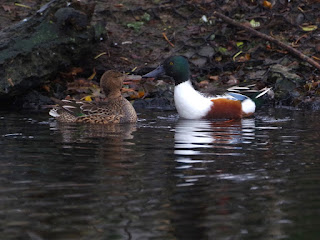Usually Little Grebes circulate round the lake, but this one seems to have found a good spot and is staying there.
Just the other side of the bridge, a Cormorant was fishing over the wire baskets of twigs which serve as a fish hatchery. But this area is pretty well fished out, and it didn't catch anything while I was there.
The same Cormorant balanced precariously as it walked up a chain to get on to a post.
Another was drying its wings on the fallen chestnut tree near Peter Pan, ignoring the drizzle which was probably making them wetter.
At the island, the Grey Heron was on the nest again.
The pair really do seem to be reclaiming it, long before the breeding season. Its mate was in the water below, getting out of its depth. Herons can swim, but not well and they avoid it if possible.
Most of the Herring Gulls on the Serpentine are young, first- or second-winter birds. This must reflect prodigious breeding success at the nearby nest sites in Paddington.
At the Vista, the pale Mallard drake was beside a normal one. Ducks, like most birds, have two forms of the dark pigment melanin, one of them black (eumelanin) and the other reddish (phaeomelanin). This bird has low levels of the first. The technical name for this colour variation is, very obviously, 'brown'. The mutation has also reduced the iridescence of his head, which is a dull brownish green without much shine.
At the island, a pair of Shovellers confronted each other. It was not a loving greeting, because a moment later the female rushed away frantically.
A pair of Rose-Ringed Parakeets had a similar meeting in a tree near the bridge. Again, it was the female who flew off.
The female Little Owl near the Henry Moore sculpture was sitting out in the rain. She is a tougher bird than the other Little Owls, who retreat into their holes at the first sign of foul weather.
This Carrion Crow was on the edge of the lake near the Winter Wasteland. I couldn't work out what it was eating, but it seemed very intent on it and was keeping another crow away. Looking closely at the picture showed that it was a roasted chestnut -- no wonder the crow was so keen on it.
A Robin sang furiously in the Rose Garden, defending its territory from another only a few yards away.
A Wren stared at the camera from a bush in the reed bed at the east end of the Serpentine. There's a large colony of Wrens in this area.
We must have a picture of a Blue Tit occasionally, just as a reminder of how pretty they are.












That is a very large fish the Little Grebe is trying to eat. Little Grebes always surprise me.
ReplyDeleteI wish all duels were as pretty and aesthetically pleasing as the one the Robins are carrying on. I know, to them it's quite serious business. It's a bit of cognitive dissonance for me.
Wrens seem to be doing very well in the park!
The smallest birds, such as Wrens and Goldcrests, are doing well because there have been several successive mild winters with only a few frosty days.
Delete